Intel Core i7-980X Extreme: Hello, Six-Core Computing
Benchmark Results: Synthetics
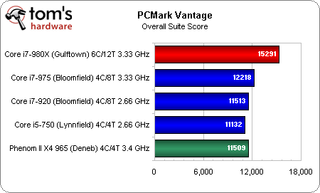

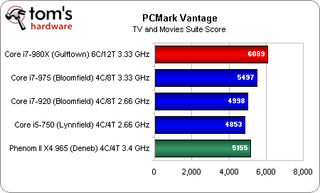

PCMark Vantage employs applications built into Windows Vista and 7. As a synthetic metric, its job is to tax the latest trends in programming for parallelism. However, it’s also real-world in that these metrics are based on operating systems already being used today.
It’s interesting to see just how much of an impact two additional cores has on Vantage. The overall suite score jumps far above the Bloomfield-class CPUs, which themselves are little affected by differences in clock rate. The Phenom II X4 965 Black Edition matches pace fairly easily to the pricier Core i7-920 here.
The Memories suite is less influenced by cores, seeming to favor the higher clocks of the Core i7-980X and Core i7-975 versus more affordable models.
On the other hand, TV and Movies and the Productivity test are both bolstered via Intel’s six-core offering. Notable in both metrics is that the Phenom II maintains its near-parity with the entry-level Core i7 and lone Lynnfield-based Core i5 processors.

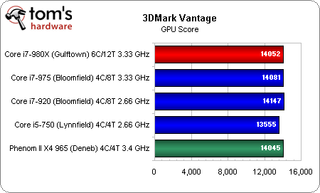

The overall 3DMark Vantage chart shows a gradual progression up Intel’s Core i5 and Core i7 family, culminating with the new i7-980X. Meanwhile, the Phenom II X4 hands out at the bottom of the pack, next to Intel’s Core i5-750.
Why is this? After all, the GPU score clearly shows four of the five testing platforms performing almost identically. The CPU test tells the tale, as Intel’s hexa-core model cuts through the physics and AI being thrown at it significantly faster than its competition. We can also see that Hyper-Threading has an appreciable effect, as the i7-920 and i5-750, both running at 2.66 GHz, are fairly well-differentiated. The Phenom II X4 brings up the tail end of the pack here.

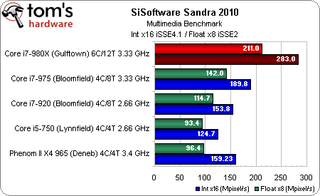
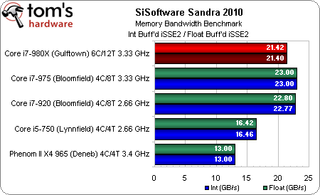

SiSoftware’s synthetic suite demonstrates the potential gains attributable to a six-core, 12-thread-capable processor by blowing the doors off of Intel’s previous flagship in the Arithmetic and Multi-media tests.
Stay on the Cutting Edge
Join the experts who read Tom's Hardware for the inside track on enthusiast PC tech news — and have for over 25 years. We'll send breaking news and in-depth reviews of CPUs, GPUs, AI, maker hardware and more straight to your inbox.
Memory bandwidth actually drops a bit on the Gulftown-based processor, despite using the same motherboard, triple-channel memory kit, and BIOS configuration. Core i7-980X nevertheless maintains a strong lead over Intel’s dual-channel Lynnfield setup and AMD’s dual-channel Phenom II X4. In discussing with Intel, this is more of an artifact of the application itself, which only takes advantage of four cores, yet still ties up resources on the two cores that remain unutilized.
Perhaps the craziest chart is our Cryptography benchmark, demonstrating the theoretical AES bandwidth gain in MB/s attributable to AES-NI support in Gulftown. This hardware-accelerated boost doesn’t manifest itself so dramatically in the real-world tests coming up, but it’s interesting to see anyway.
Current page: Benchmark Results: Synthetics
Prev Page Test Setup And Benchmarks Next Page Benchmark Results: Media And Transcoding Apps-
one-shot shuffman37First Comment, I'll be staying up to read this review =)Reply
I'm guessing you didn't read this.
http://www.tomshardware.com/news/toms-hardware-reviews-news-comments,9855.html -
tipmen Hm, not bad at all more cores at the same price as 975. Games don't seem to scale that much but CAD and transcoding is improved overall. Glad to see AMDs 965 hold its own in the game segment.Reply -
one-shotI'm guessing you didn't read this.http://www.tomshardware.com/news/t ,9855.htmlNope, Haven't bothered looking at that. The 980x doesn't really make any difference in gaming but I wasn't expecting anything earth shattering. Does look good against the 965 x4 for mutlimedia applications.Reply
-
tipmen shuffman37Nope, Haven't bothered looking at that. The 980x doesn't really make any difference in gaming but I wasn't expecting anything earth shattering. Does looks good against the 965 x4 for mutlimedia applications.Reply
It is a good reminder how to act on toms you should read it when you get the chance. -
gkay09 Lolz...The Crysis benchmark and the Chris's starting line...Am sure he would have been forced to post that so that no one start with the infamous tag line "But can it play Crysis ?" :PReply -
gkay09 And Chris it would be nice if you could post some benchmarks of games that are CPU taxing like the GTA IV/ FSX...Most of the games used in the above benchmarks dont tax the CPU as much as these...Reply -
cangelini I hear you there gkay...I used to do more with GTA IV (not sure how prolific FS X still is), but it just depends on how many folks still want to see it. As a *general* rule, $1,000 CPUs aren't going to do much for your high-res gaming. However, it's a good point that there are a couple of titles notorious for hitting graphics far less than host processing power!Reply -
pinkfloydminnesota NO GTA IV? Should get great gains as it's notoriously CPU limited by the best quad cores. Unforgivable.Reply
Most Popular


